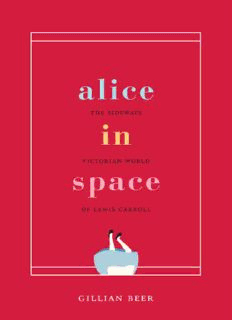
Alice in Space: The Sideways Victorian World of Lewis Carroll PDF
Preview Alice in Space: The Sideways Victorian World of Lewis Carroll
alice in space alice The SidewayS in VicTorian world space of lewiS carroll Gillian Beer The University of Chicago Press • Chicago and London The University of Chicago Press, Chicago 60637 The University of Chicago Press, Ltd., London © 2016 by The University of Chicago All rights reserved. Published 2016. Printed in the United States of America 25 24 23 22 21 20 19 18 17 16 1 2 3 4 5 iSBn- 13: 978- 0- 226- 04150- 6 (cloth) iSBn- 13: 978- 0- 226- 40479- 0 (e- book) doi: 10.7208/chicago/9780226404790.001.0001 The University of Chicago Press gratefully acknowledges the generous support of the Frederic Ives Carpenter Lectures toward the publication of this book. Library of Congress Control Number: 2016949286 ♾ This paper meets the requirements of anSi/niSo Z39.48- 1992 (Permanence of Paper). Contents Acknowledgments vii Introduction 1 1 Alice in Time 27 2 “The Faculty of Invention”: Games, Play, and Maths 45 3 Puns, Punch, and Parody 75 4 The Dialogues of Alice: Pretending to Be Two People 103 5 Are You Animal—Vegetable—or Mineral?: Alice’s Identity 135 6 “Must a name mean something?” Alice asked doubtfully 157 7 Dreaming and Justice 173 8 Growing and Eating 209 Epilogue 245 Notes 251 Selected Bibliography 269 Index 285 Acknowledgments This book is the outcome of many years of pleasure and some puzzle- ment. I am grateful to the many people who have helped me, questioned me, invited me, and who have enjoyed reading the Alice books aloud or in silence. I am indebted to the Leverhulme Trust for giving me an Emeri- tus Fellowship that made possible the book’s completion, and to the Yale Center for British Art and its director, Amy Meyers, for their hospitality over several years and the scholarly opportunity of living among those who think through images. I am grateful, too, to Girton College and Clare Hall College at the University of Cambridge, both of whom gave me every kind of support. Libraries are essential to such a project, and this one was begun be- fore the Internet brought materials readily to hand that used to take many months of scouring: the University Library, Cambridge; the Gir- ton College Library, Cambridge; the English Faculty Library, Cambridge; Christ Church Library, University of Oxford; the Stirling Library and the Beinecke Library, Yale University; and the Ruskin Library, University of Lancaster, together provided a marvelous array of materials and help from their librarians. The book sprang first from invitations to give named lecture series at University College London and the University of Chicago. Many other institutions and societies, including Tate Liverpool, Harvard University, University of Nancy, the Stockholm National Theater, the International viii acknowledGmenTS Society for Dialogue Studies, Hay- on- Wye Literary Festival, the Cam- bridge Literary Festival, the Brighton Festival, and the North Ameri- can Victorian Studies Association, helped me to take further my ideas through the discussions they provoked. Members of the UK Lewis Car- roll Society have been helpful and informative and their journals are a great resource. Students in seminars at Cambridge, Chicago, and New Haven contributed fundamentally, as did the participants in Synapsis at Siena over a number of years. Earlier, diverse, and shorter versions of chapter 1, “Alice in Time,” appeared in Alice in Wonderland through the Visual Arts (London: Tate Publishing, 2011), 120–28; Modern Language Review 106 (October 2011); “The Presidential Address of the Modern Humanities Research Asso- ciation” (2011), xxvii– xxxviii; and Nature 479 (November 2011): 38–39. An earlier version of chapter 6, “Must a Name Mean Something?” ap- peared in I colori della narrative: Studi offerti a Roberto Bigazzi, ed. Andrea Matucci and Simona Micali (Rome: Aracne, 2010), 163–80. Inevitably, with the length of time that books take in production, volumes have ap- peared since my work was more or less completed that I would have liked to engage with more fully: in particular, Robert Douglas-F airhurst’s The Story of Alice (2015) offers a rich account of the lives of Charles Dodgson and Alice Liddell. Hugh Haughton’s Centenary Edition (London: Penguin Classics, 1998, and frequently reprinted) gathers all three Alice books as well as Lewis Carroll’s later essay “‘Alice’ on the Stage” and two of his prefaces. Together with Haughton’s notes this offers a valuable basis for discussion and it is to this edition that all my Alice references refer. I am grateful to Hugh Haughton for his work. So much of life is caught into learning and I must thank many friends for their encouragement and their conversation, about many things be- sides Alice. In particular I owe a debt of gratitude to Trudi Tate who helped me immeasurably by checking and editing and discussing the typescript with me over several months. Edward Wakeling was generous with his matchless knowledge of Lewis Carroll when I was editing and annotating Carroll’s collected poems for Penguin Classics in 2012 as Jabberwocky and Other Nonsense. Sally Shuttleworth gave me the push over the hump that was needed to finish the book. Alan Thomas at the University of Chicago acknowledGmenTS ix Press has been patient and supportive. My thanks to Therese Boyd for her scrupulous and good- humored copyediting. Many friends made it all happen: Tim Barringer, Homi Bhabha, Roberto Bigazzi, Rachel Bowlby, Daniel Brown, Laura Caretti, Santanu Das, Maud Ellmann, Helen Hignall, Mary Jacobus, Ludmilla Jordanova, Evelyn Fox Keller, Andy Martin, Cathy Moore, Ruth Padel, Jan Schramm, Helen Small, Ali Smith, Susan Stewart, Marina Warner, and Alison Win- ter, among them. My husband and family helped in many different and irreplaceable ways, above all by being there. The book is dedicated to our grandchildren: Zarina and Ariana, and—for a second time—Sam, Ella, and Sophia. They all share Alice’s curiosity, and her good- will.
Description: